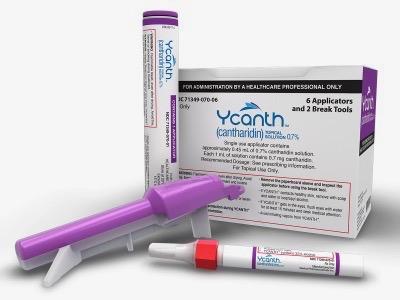Cantharidin Topical Side Effects
Medically reviewed by Drugs.com. Last updated on Sep 24, 2024.
Applies to cantharidin topical: topical application solution.
Precautions
It is very important that your doctor check your progress closely to make sure that this medicine is working properly. Blood tests may be needed to check for unwanted effects.
This medicine may cause eye problems if it gets into your eyes. Check with your doctor right away if you or your child has blurred vision or blue-green halos seen around objects, dry eyes, or sensitivity of the eyes to light.
Skin reactions may occur after treatment with this medicine. Check with your doctor right away if you have breakdown of the outer layer of skin, dry skin, lightening or darkening of the skin, or small fluid filled or non-fluid filled raised blisters on or around the treated areas. You may wash the treated area with soap and water 24 hours after application. Do not use a washcloth, abrasive material, or vigorous rubbing because it could be painful.
Serious side effects of cantharidin topical
Along with its needed effects, cantharidin topical may cause some unwanted effects. Although not all of these side effects may occur, if they do occur they may need medical attention.
Check with your doctor immediately if any of the following side effects occur while taking cantharidin topical:
More common side effects
- changes in color of the skin
- flushing, redness of the skin
- skin ulcers
- swelling of the skin
- unusually warm skin
Incidence not known
- blurred vision or blue-green halos seen around objects
- dry eyes
- sensitivity of the eyes to light
See also:
For healthcare professionals
Applies to cantharidin topical: topical liquid.
General adverse events
Adverse reactions were primarily local skin reactions at the application site which was reported in 97% of patients and discontinuation due to adverse reactions was reported in 2.3% of patients.[Ref]
Dermatologic
- Common (1% to 10%): Moderate contact dermatitis[Ref]
Local
- Very common (10% or more): Mild application site dryness (19%), mild application site discoloration (28%), mild application site erythema (24%), mild application site scab (39%), mild application site pruritus (47%), mild application site pain (41%), mild application site vesicles (60%)
- Common (1% to 10%): Mild application site erosion, mild application site edema[Ref]
References
1. "Product Information. Ycanth (cantharidin topical)." Verrica Pharmaceuticals Inc
More about cantharidin topical
- Compare alternatives
- Reviews (1)
- Dosage information
- During pregnancy
- Drug class: topical keratolytics
- En español
Patient resources
Other brands
Professional resources
Other brands
Related treatment guides
Further information
Cantharidin topical side effects can vary depending on the individual. Always consult your healthcare provider to ensure the information displayed on this page applies to your personal circumstances.
Note: Medication side effects may be underreported. If you are experiencing side effects that are not listed, submit a report to the FDA by following this guide.

